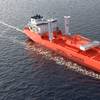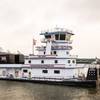The Gulf Responder is a 45-ft. aluminum catamaran designed to operate in oil and hazardous chemical spills. Currently under construction at Scully's Fabricating in Louisiana, the vessel's expected delivery date will be either late January or early February.
The 15-ton vessel is powered by twin turbo diesel engines with water jet propulsion and equipped with two 1,000 lb. MagnaPatch devices.
The MagnaPatch is a patented pollution abatement device. The device is a self-propelled, flexible, magnetic membrane that covers and seals the damages on oil and chemical bulk carrier hulls.
Spanning 100 sq. ft. in total area, the MagnaPatch is 10 times larger than most hull penetrations. Weighing more than 1,000 lbs., the MagnaPatch is powerful enough to pick up a small car. This new technology that addresses an expensive shipping problem: leaking tankers and barges.
With the passage of OPA 90, the strictest oil pollution liability law in the world, cleanup costs have soared more than 700 percent and spillers have significant incentives to limit their economic losses.
The transportation of oil in tankers and barges is a process that inherently creates high risk for the shipper. Oftentimes, an aging plate steel hull is the only barrier between the safe transportation of oil and an environmental catastrophe.
In the case of structural failure, vessels simply bend and fatigue to the point of cracking. When vessels ground, the hull can be torn open. In the event of a collision or ramming, the impact may breach the hull.
The costs of oil spills range from a few hundred dollars per barrel of oil spilled to thousands of dollars per barrel. Hull injuries represent the most costly of oil spills. Uncontrolled, a waterline breach can completely empty the damaged tank, resulting in millions or even tens of millions of dollars in losses.
MagnaPatch, Inc. was initiated to capitalize on the legal and economic advantages of reducing oil pollution. It is well known there are only two ways to reduce oil spill losses: reduce the frequency of events or reduce the consequences of the events.
The MagnaPatch can reduce the quantity of oil spilled, thereby reducing the consequences of the oil spill event.
When oil spills occur, existing cleanup technologies have only limited effectiveness, recovering only 5-15 percent of the spilled oil. The MagnaPatch can actually stop the continued discharge of oil from a damaged tanker, keeping up to 85 percent of the tank contents from contaminating the water.
During the oil spill, the MagnaPatch is lowered into the water next to the vessel. Responders utilize sonar to locate and determine the extent of the hull injury. Waterjet thrusters force the MagnaPatch over the hull breach while powerful electromagnets lock onto the hull compressing the facing material to form a seal. An effective seal stops oil from spilling and stops water from flooding the vessel.
The Magna-Patch Responder vessel is equipped with a hull imaging system that called the "acoustic flashlight." This acoustic device produces near-photo-quality images of a vessel hull day or night, even in turbid or oily water.
The acoustic sonar is used to locate impact damages, hull penetrations, or cracks in the vessel's side-shell plating.
The MagnaPatch device establishes a membrane hull closure over a damaged vessel hull. Once in place, a hydrostatic balance is achieved between the external seawater and the tank contents.
A series of test procedures were conducted by independent engineering firms to simulate the full scale application of the MagnaPatch. The tests were designed to demonstrate the efficiency of the MagnaPatch in controlling the discharge of pollutants from the side tanks of ocean-going tank vessels or inland waterway barges.
The engineering reports determined the MagnaPatch was "extremely effective" at establishing an underwater barrier between the tank contents and the surrounding water. The resulting 5,000 gallon a minute leak was controlled to less than 10 gallons per minute.
Subscribe for
Maritime Reporter E-News
Maritime Reporter E-News is the maritime industry's largest circulation and most authoritative ENews Service, delivered to your Email five times per week









